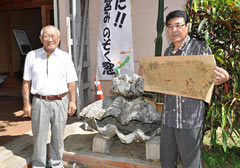Former University of the Ryukyus engineering official contributes 200 kilogram giant clam to Nago City

Hideo Nakamura (left) contributed a giant clam weighing over 200 kilograms to Nago Museum. Nago City Assembly member Masaki Kamiyama liaised between Nakamura and the musuem. At Nago Museum on August 31.
September 6, 2013 Ryukyu Shimpo
Eighty-four-year-old Hideo Nakamura used to conduct submersible surveys in various areas in Okinawa as an engineering official at the University of the Ryukyus. Nakamura contributed a 200 kilogram giant clam, barrel sponges and fishing gear to Nago Museum on August 31. He collected the clam in the sea off Kudaka Island and the barrel sponges in Oura Bay.
Nakamura, who fished in the Henoko area around 1947 after the Battle of Okinawa, said, “For me, Henoko and Oura Bay are “Life-giving gardens.” He went on to say, “The central government plans to reclaim the area, but I want Nago residents to understand the richness of the environment in the sea off the east coast of Okinawa.”
Barrel sponges are a barrel-shaped invertebrate organism. They take in nourishment by continually pumping water through the interior of the sponge. They are 45 centimeters wide and 35 centimeters high. The clam is 114 centimeters wide. It takes four adult men to lift it up. Nakamura found the clam and sponges during his submersible surveys in the 1980s.
He also gave sinkers for drive fishing and tide tables to the museum.
The fish disappeared in the sea around the Motobu area of Okinawa due to the naval bombardment by the U.S. military in the war. Around 1947, Nakamura and others carried a sabani boat down from the hills and fished in the Henoko and Higashi Village areas.
Nakamura said, “We traded fish for rice and the people of Henoko appreciated this as a valuable source of protein.” He went on to say, “The central government plans to reclaim the sea off Henoko to build a new U.S. military base, but I wanted to show gratitude to the sea that has helped us.”
Nakamura said, “The sea off Henoko and the east coast of Okinawa is rich in marine life. I want the people of Nago to understand this.” The museum displays the clam beside the front door so visitors can easily see it.
(English translation by T&CT, Mark Ealey)
Previous Article:Okinawa to build logistics center in Naha
Next Article:Okinawa to set up a council to restore prefecture’s exceptional longevity
[Similar Articles]
- New Henoko base construction may destroy area’s coral reef
- Government to expand restricted area for fishing two kilometers off the coast of Henoko
- One of a kind! An armored deep sea fish? Churaumi Aquarium displays the rare oni armored searobin for the first time ever
- Okinawa Churaumi Aquarium displays a rare deep-water fish
- Okinawa Government starts diving operation to investigate possible damage to coral reef
 Webcam(Kokusai Street)
Webcam(Kokusai Street)


